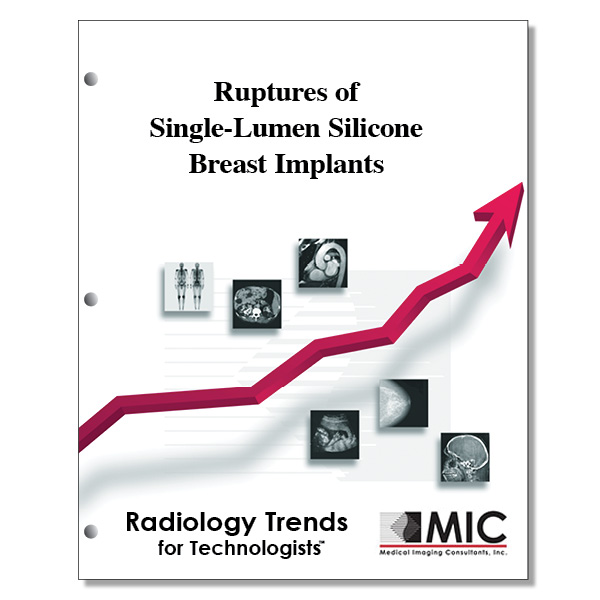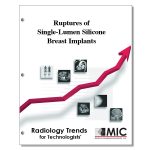

Ruptures of Single-Lumen Silicone Breast Implants
The benefits and limitations of mammography, ultrasound, and MRI are presented for their ability to identify silicone implant rupture.
Course ID: Q00537 Category: Radiology Trends for Technologists Modalities: Mammography, MRI, Sonography2.25 |
Satisfaction Guarantee |
$24.00
- Targeted CT
- Outline
- Objectives
Targeted CE per ARRT’s Discipline, Category, and Subcategory classification for enrollments starting after March 18, 2024:
[Note: Discipline-specific Targeted CE credits may be less than the total Category A credits approved for this course.]
Breast Sonography: 2.25
Patient Care: 1.25
Patient Interactions and Management: 1.25
Procedures: 1.00
Breast Interventions: 1.00
Mammography: 2.25
Procedures: 2.25
Mammographic Positioning, Special Needs, and Imaging Procedures: 2.25
Magnetic Resonance Imaging: 1.50
Procedures: 1.50
Body: 1.50
Registered Radiologist Assistant: 2.25
Procedures: 2.25
Thoracic Section: 2.25
Sonography: 1.00
Procedures: 1.00
Superficial Structures and Other Sonographic Procedures: 1.00
Outline
- Introduction
- Mammography
- Ultrasonography
- Technical Considerations
- Normal Appearance
- Capsule-Shell Complex
- Intracapsular Rupture
- Intracapsular Rupture Mimics
- Extracapsular Rupture
- MR Imaging
- Technical Considerations
- Determining Implant Type
- Normal Appearance
- Contour Abnormalities
- Intracapsular Rupture
- Intracapsular Rupture Mimics
- Extracapsular Rupture
- MR Imaging with Intravenous Contrast Agent
- Cohesive Implants
- Conclusion
Objectives
Upon completion of this course, students will:
- know the number of breast augmentation procedures performed in the U.S. annually
- recognize the most common type of breast implant used today
- identify the improvements made in fourth- and fifth-generation implants
- realize the average lifespan of a silicone-gel filled implant
- define intracapsular rupture
- define extracapsular rupture
- know the type of rupture mammography is useful for detecting
- know the sensitivity of mammography, US, and MR imaging for the detection of silicone implant rupture
- identify the imaging modality suggested for use in initial evaluation of suspected rupture
- describe the speed of sound through a silicone implant compared to that of a saline implant
- recognize the normal appearance of a single-lumen silicone implant at US
- notice bulges and herniations of the implant’s elastomer shell at US
- name the classic US signs of intracapsular rupture
- realize which US sign of intracapsular rupture is the equivalent to the MRI “linguine” sign
- identify a reverberation artifact
- identify an echogenic noise artifact
- know what an echogenic noise artifact signifies
- be aware of the artifact that may result at US when imaging cohesive implants
- cite the stance of the U.S. FDA with regard to surveillance screening with MRI of silicone implants
- recognize for what types of breast implants MR imaging should be used for rupture assessment
- be familiar with the appearance of the images from a silicone-only pulse sequence
- realize the image acquisition method used to differentiate early intracapsular rupture from complex radial folds
- know the type of MRI pulse sequence used to distinguish the fill materials of a breast implant
- describe how both silicone and saline appear on T2-weighted images
- describe how both silicone and saline appear on T1-weighted images
- know which implants have fill valves
- recognize the normal appearance of the fibrous capsule on a T2-weighted image
- name the MR imaging sign of an uncollapsed rupture
- name the degree of collapse when the extruded silicone separates the implant elastomer shell from the fibrous capsule
- identify the MR imaging sign of a partial to full collapse
- recognize MR imaging artifacts that mimic intracapsular rupture
- state the MR imaging pulse sequence that’s particularly useful and sensitive for identifying extracapsular free silicone gel
- know for what MR imaging breast studies a BI-RADS score is required
- identify the other name for cohesive breast implants
- describe the design of cohesive breast implants
